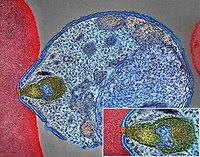
Photo from wikipedia
BACKGROUND Malaria elimination requires targeting asymptomatic and low-density Plasmodium infections that largely remain undetected. Therefore we conducted a cross-sectional study to estimate the burden of asymptomatic and low-density Plasmodium infection… Click to show full abstract
BACKGROUND Malaria elimination requires targeting asymptomatic and low-density Plasmodium infections that largely remain undetected. Therefore we conducted a cross-sectional study to estimate the burden of asymptomatic and low-density Plasmodium infection using conventional and molecular diagnostics. METHODS A total of 9118 participants, irrespective of age and sex, were screened for malaria using rapid diagnostic tests (RDTs), microscopy and polymerase chain reaction. RESULTS Among the participants, 707 presented with symptoms and 8411 without symptoms, of which Plasmodium was present in 15.6% (110/707) and 8.1% (681/8411), respectively. Low-density infection was found in 5.1% (145/2818) of participants and 8327 of 9118 were Plasmodium negative. Endemicity was propotional to asymptomatic infections (high endemicity 11.1% [404/3633] vs low endemicity 5.8% [277/4778]; odds ratio [OR] 2.0 [95% confidence interval {CI} 1.7 to 2.4]) but inversely related to low-density infection (high endemicity 3.7% [57/1545] vs low endemicity 6.9% [88/1273]; OR 1.9 [95% CI 1.4 to 2.7]). The spleen rate in children 2-9 y of age was 17.9% (602/3368) and the enlarged spleen index was 1.6. Children between 8 and 14 y showed higher odds for asymptomatic (adjusted OR [aOR] 1.75 [95% CI 1.4 to 2.2]) and low-density infections (aOR 0.63 [95% CI 0.4 to 1.0)] than adults. CONCLUSIONS The prevalence of asymptomatic and low-density Plasmodium infection undermines the usefulness of standard diagnostic tools used by health agencies. This necessitates deploying molecular tools in areas where malaria microscopy/RDTs indicate a dearth of infection.
Journal Title: Transactions of the Royal Society of Tropical Medicine and Hygiene
Year Published: 2021
Link to full text (if available)
Share on Social Media: Sign Up to like & get
recommendations!